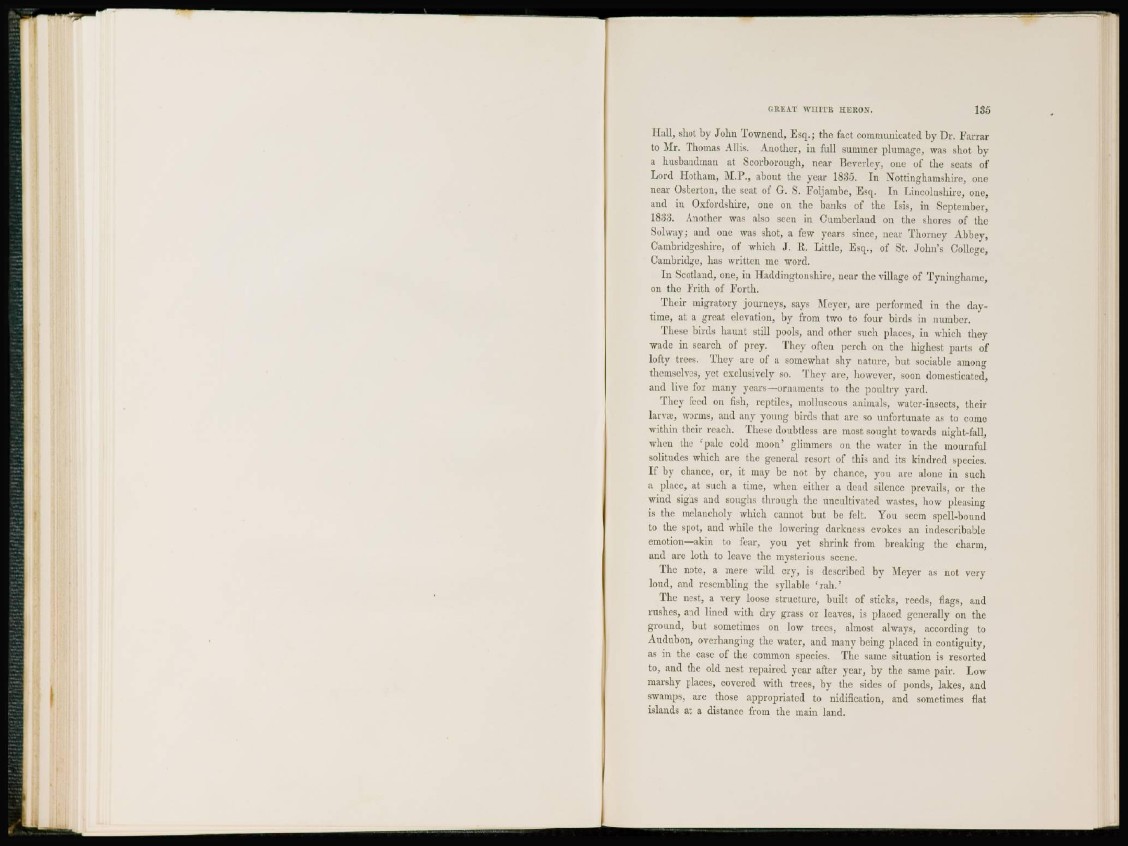
GREAT WHITE HERON. 1S5
Mall, shot by John Townend, Esq.; the fact communicated by Dr. Farrar
to Mr. Thomas Allis. Another, in full summer plumage, was shot by
a husbandman at Scorborough, near Beverley, one of the seats of
Lord Hotham, M.P., about the year 1830. In Nottinghamshire, one
near Osbertou, the seat of G. S. Foljambe, Esq. In Lincolnshire, one,
and in Oxfordshire, one on the banks of the Isis, in September,
1833. Another was also seen in Cumberland on the shores of the
Sol way; and one was shot, a few years since, near Thorncy Abbey,
Cambridgeshire, of which J. R. Little, Esq., of St. John's College,
Cambridge, has written me word.
I n Scotland, one, iu Haddingtonshire, near the village of Tyninghame,
on the Frith of Forth.
Their migratory journeys, says Meyer, arc performed in the daytime,
at a great elevation, by from two to four birds in number.
These birds haunt still pools, and other such places, in which they
wade in search of prey. They often perch on the highest parts of
lofty trees. They arc of a somewhat shy nature, but sociable among
themselves, yet exclusively so. They arc, however, soon domesticated,
and live for many years—ornaments to the poultry yard.
They feed on fish, reptiles, molluscous animals, water-insects, their
larva?, worms, and any young birds that arc so unfortunate as to come
within their reach. These doubtless are most sought towards night-fall,
when the (palc cold moon' glimmers on the water in the mournful
solitudes which are the general resort of this and its kindred species.
I f by chance, or, it may be not by chance, you are alone in such
a place, at such a time, when either a dead silence prevails, or the
wind sighs and soughs through the uncultivated wastes, how pleasing
is the melancholy which cannot but. be felt. You seem spell-bound
to the spot, and while the lowering darkness evokes an indescribable
emotion—akin to fear, you yet shrink from breaking the charm,
and are loth to leave the mysterious scone.
The note, a mere wild cry, is described by Meyer as not very
loud, and resembling the syllable ( r a h .'
The nest, a very loose structure, built of sticks, reeds, Hags, and
rushes, and lined with dry grass or leaves, is placed generally on the
ground, but sometimes on low trees, almost always, according to
Audubon, overhanging the water, and many being placed in contiguity,
as in the case of the common species. The same situation is resorted
to, and the old nest repaired year after year, by the same pair. Low
marshy places, covered with trees, by the sides of ponds, lakes, and
swamps, are those appropriated to nidification, and sometimes flat
islands at a distance from the main land.